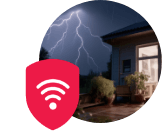Verizon Fios Fiber vs. Xfinity Cable

Table of Contents
Choosing between Verizon Fios Fiber vs. Xfinity cable? With Verizon’s fiber network delivering lightning-fast symmetrical speeds and Xfinity’s sprawling cable empire reaching over a third of American homes, the decision comes down to what matters most: raw performance or broad availability.
Let’s examine how these internet giants compare.
[search_block]
Speed
Verizon Fios runs on 100% fiber-optic technology, which means your upload speeds match your download speeds. Stream a 4K video conference while your kids game online? No problem. Fios delivers 300Mbps, 500Mbps, 1 Gig, or even 2 Gig speeds—and those upload rates keep pace.
Xfinity takes a different approach. As America’s largest cable provider, it relies on hybrid fiber-coaxial connections. You’ll find impressive download speeds reaching up to 10 Gbps in select areas, but here’s the catch: upload speeds lag far behind. A 1 Gig plan may only provide 35Mbps for uploads. For remote workers juggling video calls and large file transfers, that gap stings.
Speed winner: Verizon Fios because symmetrical speeds win every time for modern internet usage.
Pricing
Verizon keeps pricing straightforward. Four tiers, ranging from around $35 to $100 monthly (with automatic payments), and here’s the kicker: price-lock guarantees from three to five years, depending on your plan—no surprise bill increases after year one.
Xfinity offers attractive promotional rates starting around $40 per month, but reality sets in when the promo period ends. Your bill can jump 50% or more after the first year. Factor in the $15 monthly equipment fee after your promo ends, and costs climb higher.
Winner: Verizon Fios because transparent pricing beats promotional trickery.
Availability
Here’s where Xfinity flexes its muscles. The cable provider reaches 40 states, covering 35% of the U.S. [1]. Check almost any address, and Xfinity probably offers service.
Verizon Fios? Just nine northeastern states [2]. That changes soon—Verizon’s acquisition of Frontier Fiber should expand coverage to 25 states by 2026. However, right now, geography determines whether Fios remains a fantasy or becomes a reality for you.
Winner: Xfinity because availability matters when fiber isn’t an option.

Analyzing the extra charges
Hidden Fees and Data Caps
Verizon bundles equipment costs into monthly rates with no data caps whatsoever. Stream, game, and work without watching the meter. Installation runs $99 for most plans (waived for 1 Gig subscribers), and that’s it for one-time fees.
Xfinity includes unlimited data during promotional periods. Xfinity’s lower-tier plans have data caps that apply under certain conditions. The data cap is 1.2 TB (terabytes) per month, which is sufficient to cover the monthly usage of many households without any issues. Xfinity claims that it does not throttle internet and slow it down, however, Xfinity will charge you overage fees if you exceed your data cap. With Xfinity’s higher-tier plans, you will get unlimited data. Equipment costs $15 per month once promotions expire, unless you supply your own compatible gear. Self-installation usually costs nothing, but professional setup adds $100.
Winner: Verizon Fios, because there are no data caps, meaning true unlimited usage.
Customer Satisfaction
Recent American Customer Satisfaction Index scores reveal interesting patterns. Verizon Fios earned 76 out of 100 points, a point lower than its score last year. Xfinity scored 69 points, which was 3% higher than 2024’s score [3].
J.D. Power rankings tell a similar story. Verizon Fios dominated the Eastern region for over a decade, scoring 578 points compared to the regional average of 541 [4]. Xfinity ranked second in the north central region with a score of 551 and second in the south region with a score of 587.
Winner: Verizon Fios because of higher satisfaction scores across major metrics.
Perks and Extras
Verizon brings serious game to the perks department. Sign up for the 1 Gig plan with a 5-year price guarantee and score a free Nintendo Switch system—or grab a Nintendo Switch accessory gaming bundle with two controllers plus a $100 gift card. That same plan includes Disney+, Hulu, and ESPN+ (with ads) for free for 12 months, then just $10 per month after.
The 500Mbps tier with a 4-year price guarantee delivers YouTube TV for $10 off monthly (just $72.99) for the first year, then $82.99 afterward. Worried about leaving your current provider? Verizon offers up to $500 in credits to help cover early termination fees, making the switch painless.
Xfinity counters with its StreamSaver bundle—Peacock Premium with ads, Netflix Standard with ads, and Apple TV+ for $15 monthly. Mobile customers can save $10 to $30 monthly on internet service for two years. Gigabit subscribers get two free years of Peacock Premium, plus access to over 20 million Xfinity Wi-Fi hotspots nationwide.
Winner: Tie. Both providers offer compelling extras depending on your needs.

The winner is…
The Verdict
- You live in the Northeast and fiber coverage reaches your address
- Symmetrical upload and download speeds matter for your work or lifestyle
- Price stability and transparent billing appeal to you
- You want consistently high customer satisfaction ratings
Choose Xfinity if:
- Verizon Fios isn’t available at your address
- You need the fastest speeds available and fiber isn’t an option
- Promotional pricing fits your budget for the short term
- You value extensive availability and don’t mind managing price increases
Neither provider offers perfection. Verizon Fios delivers superior technology but limited reach. Xfinity provides widespread availability but complicates pricing and throttles uploads. Your address and priorities determine the winner.
Find the Best Internet Provider in Your Area
Stop guessing which providers serve your neighborhood. Enter your zip code below to discover which internet plans are available at your address—with real pricing, speeds, and promotional offers. Compare options in seconds and make an informed decision.
[search_block]
FAQs
Does Verizon Fios require a contract?
No. Verizon Fios operates without term agreements on any plan, meaning no early termination fees if you cancel. The price-lock guarantee ensures rate stability without binding you to a contract.
Can I use my own router with Xfinity?
Yes, Xfinity allows compatible personal equipment, but you’ll lose access to technical support and automatic device upgrades.
What happens to my Xfinity bill after the promotional period?
Your monthly rate converts to the regular price, which typically runs 50% or higher than the promotional rate.
Sources
[1] USAtodaycom. “Xfinity vs Spectrum"
[2] Verizonspecials.com. “Availability"
[3] Theacsi.org. “Telecommunications Internet Service Providers"
[4] Jdpower.com. “2025 US Residential Internet Service Provider Satisfaction Study"







 Call
Call 

 Access Your Account
Access Your Account